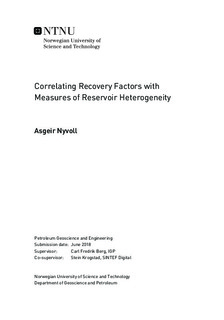Correlating Recovery Factors with Measures of Reservoir Heterogeneity
Master thesis
Permanent lenke
http://hdl.handle.net/11250/2563030Utgivelsesdato
2018Metadata
Vis full innførselSamlinger
Sammendrag
Field scale reservoir simulations are computationally intensive, and therefore also timeconsuming. This thesis focuses on the development and evaluation of computationallyeasy measures of reservoir heterogeneity, by comparing their correlation with recoveryfactors after waterflooding and tertiary polymer injection. Expected recovery is related toheterogeneity, as heterogeneities increase the chance of bypassed oil during a waterflood.While field scale simulations include multiple fluid phases and many time steps, heterogeneity measures are often based on steady-state solutions of single-phase flow, whichrequire much less computations. Heterogeneity measures can therefore be used for rapidscreening of reservoir models, including positioning of wells and other potential recoverystrategies. This allows for the evaluation of more options than what is feasible with onlyfield scale simulations. After the initial screening, the best options can then be used formore thorough considerations.
The work has been focused on new heterogeneity measures based on a model of permeabilitydescription by the use of streamlines, and heterogeneity measures from a parametercalled the diffusive time of flight. The permeability description divides the averaged permeability over a reservoir model into hydraulic conductance, tortuosity, constriction andeffective bulk volume. New measures have further been compared with existing dynamicmeasures of reservoir heterogeneity. In addition, the required code to calculate both newand existing heterogeneity measures has been implemented as an extension to the MatlabReservoir Simulation Toolbox (MRST), which is an open-source tool for reservoir simulationand evaluation developed by SINTEF. The code will be shared with the MRST teamat SINTEF, and can be included in coming releases of the software.
The results show that several heterogeneity measures are closely correlated to expected recovery. Measures from diffusive time of flight were more promising than measures basedon the permeability model, though especially tortuosity also shows correlation with recovery.However, the best correlations were found among some of the existing heterogeneitymeasures, especially sweep efficiency at 1 and 2 pore volumes injected and the dynamic Lorenz coefficient.
The best existing measures gave a Pearson correlation coefficient above 0.9, which is verysignificant. The close correlations are interesting, as they indicate that the flow fields from single-phase steady-state solutions, which the heterogeneity measures are based on, hasresemblance to the average flow fields during multiphase simulations.
